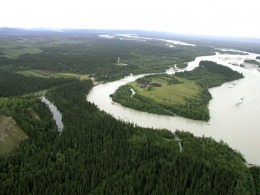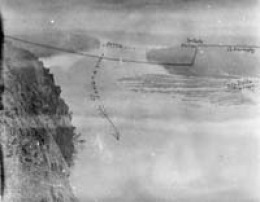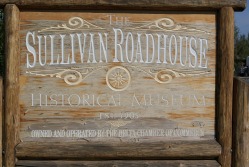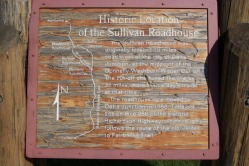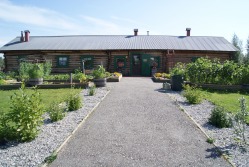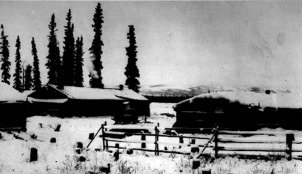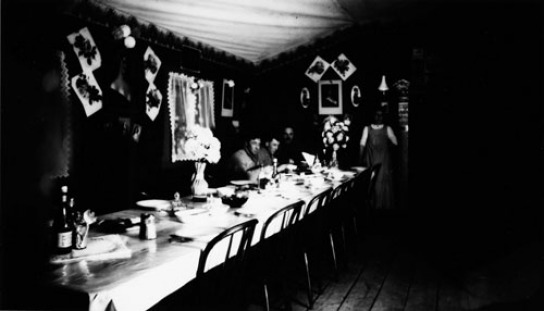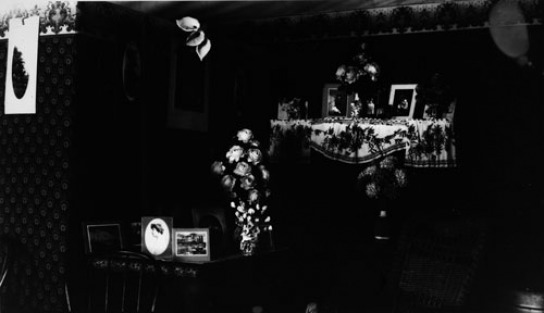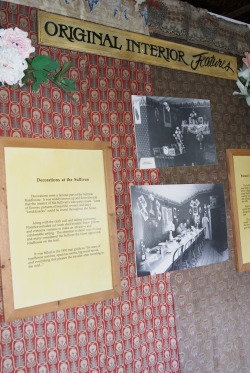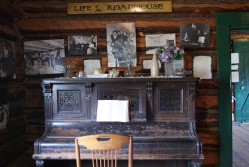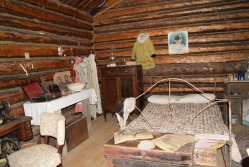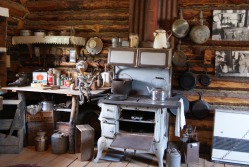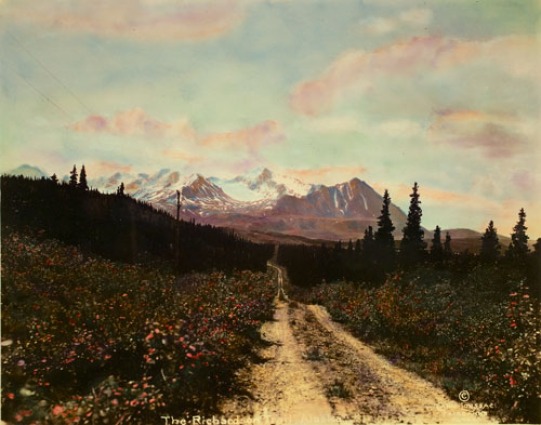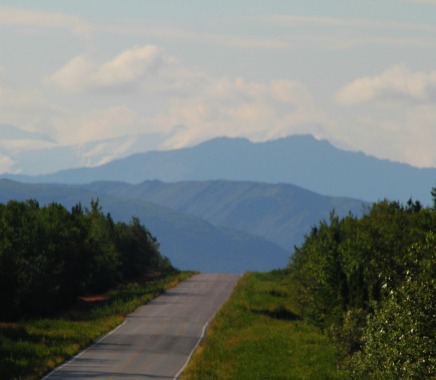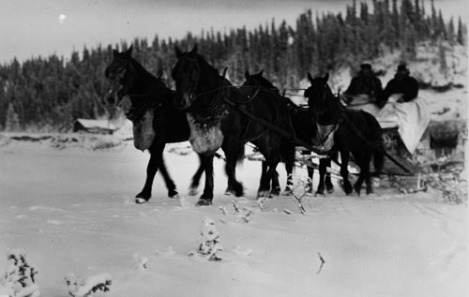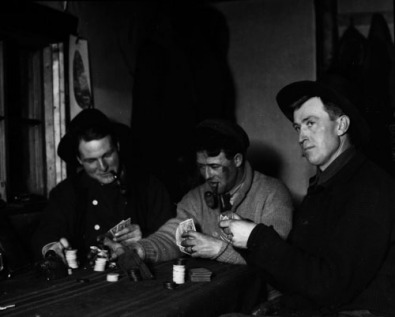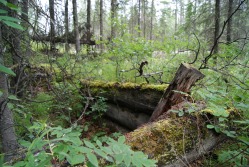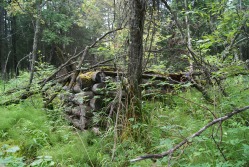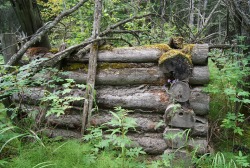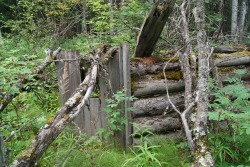Location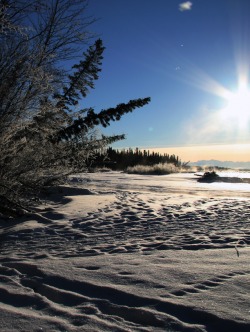
The community of Whitestone is located on the west side of the Delta and Tanana Rivers 10 miles north of Delta Junction and 90 miles south of Fairbanks in the interior of Alaska. This area is commonly known as the middle Tanana Valley. In the summer, the community is only accessible by boat on the Tanana River. Visitors utilize the Alyeska Pipeline boat landing at Mile 276 Richardson Highway or the boat dock at Rika’s Roadhouse and Landing. During the winter, a road is constructed crossing the frozen Delta River approximately a mile upstream of the Tanana River, allowing residents and visitors road access for 4-6 months of the year. During the transitional periods commonly referred to as “freeze-up” and “break-up,” access to the community is accomplished on foot or by track vehicle. No airstrip is present at this time.
|
Early History
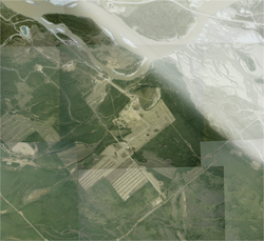
In 1902, Felix Pedro struck gold in Fairbanks, Alaska. Previous stampedes in Skagway and Juneau, and the need for more efficient communication, resulted in the establishment of telegraph stations by Lieutenant Billy Mitchell. One of these stations, a re-supply point for stampeders, was located at the Delta/Tanana confluence. In 1905, Dan McCarty bought out the inventory and began managing the station. What is now Big Delta was known as McCarty’s well into the 1930’s.
Also in 1905, Jack and Florence Sullivan established the Sullivan Road House, the largest and most opulent rest stop on the Valdez to Fairbanks Trail. Located on the Donnelly Washburn Winter Cut-off, it was a vital link in the chain of road houses, located approximately 25 miles apart, along the trail that was later to become the Richardson Highway. Sullivan Road House’s original location is approximately 16 miles southwest of Whitestone Community Association’s western border, on the edge of Fort Greely’s Oklahoma Bombing Range. Photos and further history of the Sullivan Roadhouse where it stands today in downtown Delta Junction may be viewed at:http://activerain.com/blogsview/1159494/sullivan-roadhouse-delta-junction-alaska-history. |
Big Delta in the Early Days
James T. Geoghegan writes, “Had to have some dough so went up new Valdez trail
and struck them for a job. Told me Jack Sullivan was building a road house and
wanted help. So I hiked 20 or 30 miles further and got a carpenter job with him
on the Dry Delta.”
--Geoghegan Family Papers, Box 1, Folder 3, Archives,
Alaska and Polar Regions Collections, Rasmuson
Library, University of Alaska Fairbanks
and struck them for a job. Told me Jack Sullivan was building a road house and
wanted help. So I hiked 20 or 30 miles further and got a carpenter job with him
on the Dry Delta.”
--Geoghegan Family Papers, Box 1, Folder 3, Archives,
Alaska and Polar Regions Collections, Rasmuson
Library, University of Alaska Fairbanks
"Sullivan got meat from Fairbanks and eggs and pork loins freighted in from Valdez. Nothing in summer; 2 feet of mud on trail... Sullivan had 'Canadian Club' and salmon bellies for breakfast, salted commercially on Tanana. Mrs. S. splendid cook--pies, cakes, pan bread. Canned fruit and vegetables freighted from Fairbanks in winter.
No business in summer. Folks travelled on steamboats."
--Sullivan's, Sept., 1907-8, Narrative, p. 20, Geoghegan Family Papers, Box 1, Folder 3, Archives, Alaska and Polar Regions Collections, Rasmuson Library, University of Alaska Fairbanks
No business in summer. Folks travelled on steamboats."
--Sullivan's, Sept., 1907-8, Narrative, p. 20, Geoghegan Family Papers, Box 1, Folder 3, Archives, Alaska and Polar Regions Collections, Rasmuson Library, University of Alaska Fairbanks
Valdez to Fairbanks Trail
The whole reason for the establishment of Sullivan's and several other roadhouses, was to provide food and lodging for travelers and freight traffic using the Donnelly-Washburn winter sled route (for a more detailed history, see the pdf article, available online, entitled, "Early Transportation Routes, Fort Wainwright, Alaska, by Ronald J. Burr Neely, Jr.).
This route was an attempt by the Alaska Road Commission to provide an all-weather road between Valdez and Fairbanks. It avoided the overflow and rough terrain along the main route between Big Delta and Richardson Roadhouse. It also cut off 12-15 miles from the summer trail.
Judy Ferguson writes, "In the winter, Valdez-Fairbanks north bound traffic generally crossed the mouth of the shallow Delta River at McCarty's and then connected to the Cutoff trail. It emerged at Washburn, the last stop before the last river crossing.
By 1920, the Cutoff was no longer used, and certainly by 1923, when the railroad was completed from Anchorage to Nenana, it was discontinued." --Parallel Destinies, p. 32
Part of the winter cutoff trail still exists along the Tanana River within Whitestone's boundaries. In 1982, when Whitestone community members purchased the property, blazed trees which marked the trail were still standing.
This route was an attempt by the Alaska Road Commission to provide an all-weather road between Valdez and Fairbanks. It avoided the overflow and rough terrain along the main route between Big Delta and Richardson Roadhouse. It also cut off 12-15 miles from the summer trail.
Judy Ferguson writes, "In the winter, Valdez-Fairbanks north bound traffic generally crossed the mouth of the shallow Delta River at McCarty's and then connected to the Cutoff trail. It emerged at Washburn, the last stop before the last river crossing.
By 1920, the Cutoff was no longer used, and certainly by 1923, when the railroad was completed from Anchorage to Nenana, it was discontinued." --Parallel Destinies, p. 32
Part of the winter cutoff trail still exists along the Tanana River within Whitestone's boundaries. In 1982, when Whitestone community members purchased the property, blazed trees which marked the trail were still standing.
"Four or 6 horse stage, 10 to 12 passengers, 600 lb mail, 6 times a week, 3 each way with Sunday to catch up. Passengers sat in open with charcoal 'Briquette' heater at feet. Big wolf lap robes and canvas cover over all, tucked under feet and pinned round waist with 6 inch safety pins. Covered stages make them 'sea' sick. Babes and children take it o.k. Fur coat (loan) included in fare, 40 cents a mile."
--James T. Geoghegan, Sullivans, Sept., 1907-8, Narrative, p. 20, Geoghegan Family Papers, Box 1, Folder 3, Archives, Alaska and Polar Regions Collections, Rasmuson Library, University of Alaska Fairbanks
--James T. Geoghegan, Sullivans, Sept., 1907-8, Narrative, p. 20, Geoghegan Family Papers, Box 1, Folder 3, Archives, Alaska and Polar Regions Collections, Rasmuson Library, University of Alaska Fairbanks
First Settlers
Prospecting and mining, along with easier access to the interior, brought about an influx of white settlers to Big Delta, which gradually displaced the Tanana Athabascan Indians who had lived there throughout most of the 19th and early 20th centuries.
One of the first settlers within the borders of what is now Whitestone Community Association was a hunter and prospecter named Butch Stock. In her book, Parallel Destinies, Judy Fereguson reports Ted Lowell of Fairbanks as saying, "Butch was a man who'd give anybody the dirty 'shirt off his back.' In his Alaskan hospitality, Butch always offered guests pancakes from the sourdough batter stored under his bed. If a mouse's tail was sticking out of the bowl, he simply tossed it out and whipped up the hotcakes all the same."
The remains of Butch's cabin built beside the Delta River can still be seen today. The site is located about 800 feet farther into the woods behind the first GVEA power pole on the Whitestone side of the Delta River.
Carl O Tweiten in his book, Alaska, Big Delta and the Goodpaster Region, recounts that three other cabins were built close to Butch's: one belonging to a man named Orbeck, another built by Steve Loring, the last by Lawrence and Walter Johnson. The remains of these cabins, too, are still extant.
One of the first settlers within the borders of what is now Whitestone Community Association was a hunter and prospecter named Butch Stock. In her book, Parallel Destinies, Judy Fereguson reports Ted Lowell of Fairbanks as saying, "Butch was a man who'd give anybody the dirty 'shirt off his back.' In his Alaskan hospitality, Butch always offered guests pancakes from the sourdough batter stored under his bed. If a mouse's tail was sticking out of the bowl, he simply tossed it out and whipped up the hotcakes all the same."
The remains of Butch's cabin built beside the Delta River can still be seen today. The site is located about 800 feet farther into the woods behind the first GVEA power pole on the Whitestone side of the Delta River.
Carl O Tweiten in his book, Alaska, Big Delta and the Goodpaster Region, recounts that three other cabins were built close to Butch's: one belonging to a man named Orbeck, another built by Steve Loring, the last by Lawrence and Walter Johnson. The remains of these cabins, too, are still extant.
Homesteaders
Although the Federal Homestead Act was closed down in 1976, homesteading in Alaska continued until 1986. The Whitestone area was one of the available locations.
A man named George Probert lived in Spokane, Washington. He owned a store, but he was getting tired of people not paying their bills and the general rat race of city life. By 1974, George's store had burned down. He and a group of close friends decided to hit the trail for Alaska, the land of opportunity.
George, his brother, Al, Al's son, Richard, Larry White, Mike Noonan, Billy Smith, Betty Smith, Bruce Robertson, Bob Krebbs and Pappy Moss all staked claims on the Whitestone side of the Tanana River.
After some time, George decided to move back to Washington. Just at the time he was looking to sell his homestead, the members of a church group in Claremont, New Hampshire were looking for land on which to establish a community. A man named Doug McClain living in Dry Creek, Alaska was in contact with the New Hampshire group.
Toby Williams, long-time Delta resident, knew that George's property was for sale. When Doug McClain contacted him in search of real estate for the Claremont group, Toby felt that George's parcel would be ideal. In 1982 the group purchased George Probert's homestead. The community of Whitestone had begun.
A man named George Probert lived in Spokane, Washington. He owned a store, but he was getting tired of people not paying their bills and the general rat race of city life. By 1974, George's store had burned down. He and a group of close friends decided to hit the trail for Alaska, the land of opportunity.
George, his brother, Al, Al's son, Richard, Larry White, Mike Noonan, Billy Smith, Betty Smith, Bruce Robertson, Bob Krebbs and Pappy Moss all staked claims on the Whitestone side of the Tanana River.
After some time, George decided to move back to Washington. Just at the time he was looking to sell his homestead, the members of a church group in Claremont, New Hampshire were looking for land on which to establish a community. A man named Doug McClain living in Dry Creek, Alaska was in contact with the New Hampshire group.
Toby Williams, long-time Delta resident, knew that George's property was for sale. When Doug McClain contacted him in search of real estate for the Claremont group, Toby felt that George's parcel would be ideal. In 1982 the group purchased George Probert's homestead. The community of Whitestone had begun.
